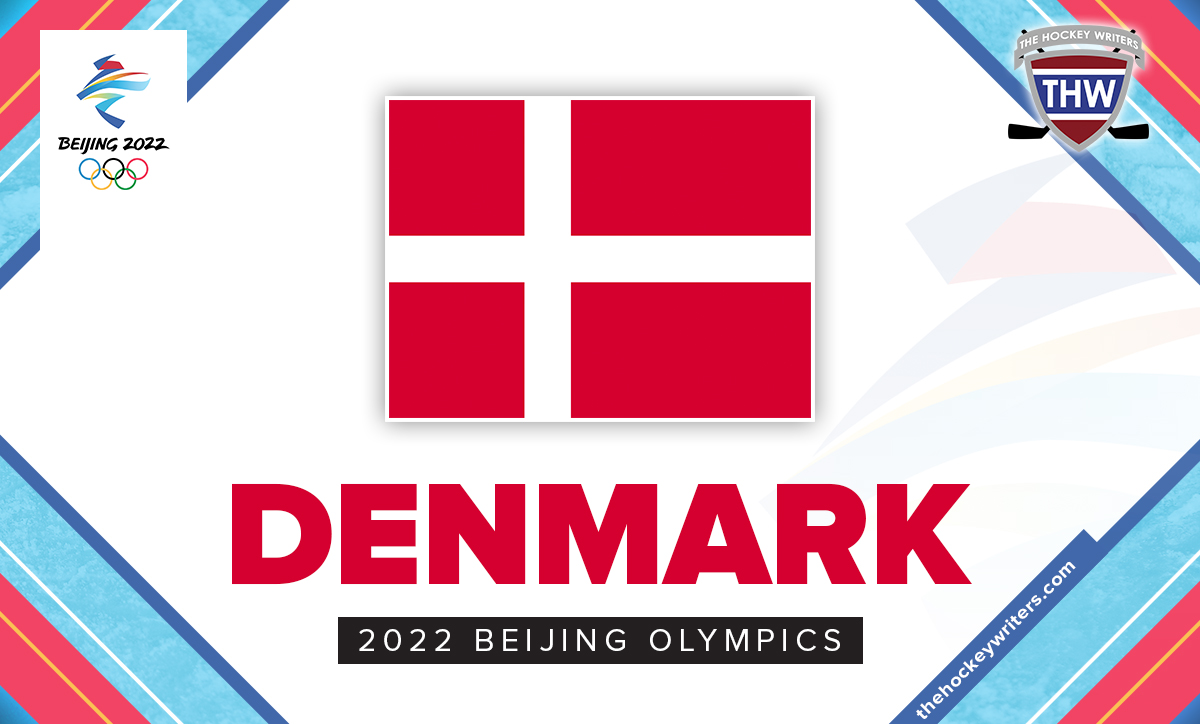In 1987, Denmark tied Japan for first place in Pool C at the World Championships in wins, but finished four goals behind, and thus lost a chance to play for the final spot in the 1988 Olympics in Calgary. In 1991, they qualified to the play-in game but lost two straight to Poland, who was given the final berth at the 1992 Olympics in Albertville, France. In 2009, they placed second at the World Championships while their Norwegian counterparts went off to Vancouver for the 2010 Olympics. And in 2013, after a strong start to the tournament, they lost their final two games by a single goal, placing them just out of reach of qualifying for the 2014 Sochi Olympics.
But finally, after 73 years of international competitions, Denmark has qualified for the Olympics. They accomplished the feat in a historic fashion, defeating Norway 2-0 on Norwegian ice, and are now ready to head to Beijing to take on the world’s best hockey players on the world’s biggest hockey stage.

While many nations may view this year as less than ideal, Denmark will certainly take full advantage of the lack of NHL talent, drawing upon several European veterans who have seen their fair share of international competition. Sure, they’d likely prefer to take Nikolaj Ehlers, Oliver Bjorkstrand, and Joakim Blichfeld, all of whom helped Denmark defeat Norway back in Aug. 2021, but even without them, the Danes are more than capable of making a big splash at their very first Olympic appearance.
Denmark’s Long Road to International Success
Denmark’s journey to the Olympics began in 1949 when they made their very first international appearance at the World Hockey Championship. Like many European countries, hockey had existed in the northern country for over 100 years, and the first hockey club was founded in 1869 in Copenhagen. However, until the 1940s, most players only played outside when it was cold enough, which made the hockey season unpredictable. But with the introduction of indoor rinks, hockey experienced a popularity boom and after just a few short seasons, they had a national team ready to take on the world.
20 years can make a huge difference, though, and Denmark was not prepared for the level of competitiveness. They had a tough matchup to start, taking on the dominant Canadians in their very first game, and it went about as well as expected. After the first period, Canada already had 13 goals, and by the end, they managed to put 47 markers past the Danish goalie. Denmark’s next game was against Austria, which also went poorly, and the final score was 25-1 in favour of the Austrians. It was humiliating. The team had three more games scheduled, but after an 8-3 loss to Belgium, they withdrew from the final two and went home, winless and in last place.
Denmark didn’t return to a World Championship until 1962 when the World Championship added a second-tier Pool B. Sadly, that went about as well as their first appearance; after five games, the Danes had five losses, including a 6-2 defeat at the hands of the Australians. But hockey was growing in popularity around the world, and in the following tournament, a third-tier Pool C was added, and Denmark was added to the next World Championships in Stockholm, Sweden. There, 14 years after their first appearance, Denmark won its first international hockey competition, beating the Netherlands 4-1. They finished the tournament in third place with three wins.
Although Denmark was the weakest of the Northern European nations, their Scandinavian blood had an affinity with the sport of hockey, and they soon began to make their way up the international standings. In 1991, they won their first World Championship tournament, going undefeated on home soil to earn a promotion to Group B. Eight years later, the tournament returned to Denmark and they once again came in first. Then, in 2002, they finally made earned a promotion to the top division, sweeping the World Championship Division I B in Hungary. Since then, they haven’t been relegated once and finished in eighth place on two occasions – 2010 and 2016.
Not long after Denmark made their top division World Championship debut, their under-20 team also made it to the top division at the World Junior Championships, debuting in 2008 with future NHL star Mikkel Boedker leading the team. Although they were relegated that year, they returned in 2012, and again in 2015, where they won their first World Junior game, beating Switzerland 4-3 in a shootout.
Fun Facts About Team Denmark & Its Players
- 14 Danes have played at least one game in the NHL, but so far, only one goalie has found his way to the league – Frederik Andersen.
- Poul Popiel became the first Danish-born player to appear in the NHL, debuting for the Boston Bruins in 1965-66 and playing 224 games over his career. However, he had become an American citizen after moving emigrating with his family in 1951.
- The first Danish trained player didn’t arrive in the NHL until 2006-07, 41 years after Popiel, when Frans Nielsen suited up for the New York Islanders. He was joined by fellow countryman Jannik Hansen in the 2007 playoffs when he appeared for the Vancouver Canucks.
- Denmark has retired one number internationally – #7 in honor of defenceman Jesper Damgaard, who was forced to retire in 2011 after a concussion.
- In 1985, Heinz Ehlers became the first Danish player to be selected in the NHL draft, going in the ninth round to the New York Rangers. 29 years later, his son, Nikolaj, went ninth overall to the Winnipeg Jets.
- Morten Green leads his nation with 119 games played at the World Championship over 19 seasons, spanning from 1998 to 2017, serving as team captain for seven of those seasons. He also leads Denmark in games played in Olympic Games Qualifiers, having appeared in five tournaments, starting in 2000.
- Denmark’s biggest came at the 1977 World Championships when they gutted Belgium 27-4.
- Denmark’s first international appearance is still its biggest loss, suffering a humiliating 47-0 loss to Canada.
Biggest Stars on the World Stage
Since Nielsen’s debut in 2006, Denmark has produced some incredibly talented players that have made their mark on the international stage. In 2010, Ottawa Senators’ star Peter Regin lead the team with two goals and seven points, propelling them to their first World Championship playoff round. Five years later, Bjorkstrand made a name for himself at the World Juniors, leading the team with four goals in five games and helping them secure their first-ever win at the tournament. Last year, Jensen set a Danish record when he scored five goals and eight points in a single tournament. And in 2018, Andersen had one of the best performances of a starting goaltender in recent memory, putting up a 0.943 save percentage over six games.

Outside of NHL talent, Denmark has seen its fair share of national heroes. Morten Madsen, a 2005 fourth-round pick of the Minnesota Wild, leads all Danes in international scoring and games played with 64 points in 139 appearances, while Jesper Jensen Aabo and Morten Poulsen lead the way with 10 years with the team. Both started in 2010, and will make their Olympic debuts together in 2022. At the World Championship, Morten Green leads the way with 59 points in 96 appearances, while Kim Staal sits in first with 20 goals. Although Andersen has some of Denmark’s best records, Sebastian Dahm has been one of Denmark’s most consistent performers, playing 31 times at the World Championship.
Where Will Denmark’s Players Come From?
Denmark’s premier hockey league is the Metal Ligaen, which was founded in 1954, and has been the top destination for nearly every one of Denmark’s best players. Andersen, Nielsen, Bjorkstrand, and Hansen all started their careers playing in this league before they went on to bigger and better things. While it doesn’t stack up against the Swedish Hockey League (SHL) or Finland’s Liiga, it still offers high-end competition that attracts players from all over Europe and North America. Julian Jakobsen, who played in the Olympic Qualifying tournament, is a top-five scorer in the league.
Outside of Denmark, most players opt to play in Sweden with the SHL or in the German Deutsche Eishockey Liga (DEL). Frederik Storm has been nearly a point-per-game player this season in the DEL, while in the SHL, Patrick Russell has been one of Linköping HC’s top scorers with 10 goals in 26 games. Many Danes also make their way to North America to play college hockey or major junior. Russell starred for St. Cloud State for two seasons, while Mads Sogaard, who currently plays for the American Hockey League’s Belleville Senators, gained recognition after starring with the Western Hockey League’s Medicine Hat Tigers.
Denmark will have another uphill battle at the 2022 Olympics, but they are no strangers to adversity. They have the experience and the tools to make a mark at their Olympic debut, even without NHL talent, and no team will enter the tournament with more to prove. While the first appearance is always a big moment, Denmark knows that they’ll need to show the hockey world why they should stick with the best hockey nations in the world. The Olympics are just the first step in a long road to international success.